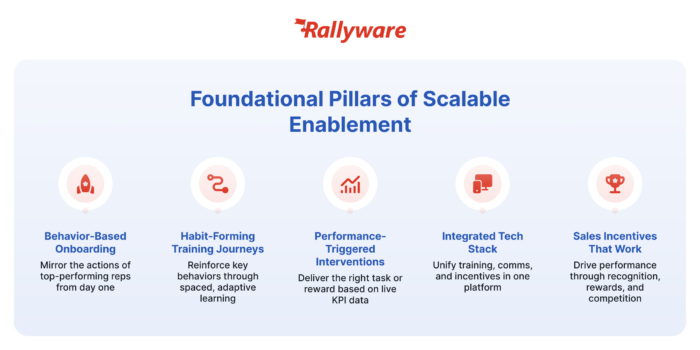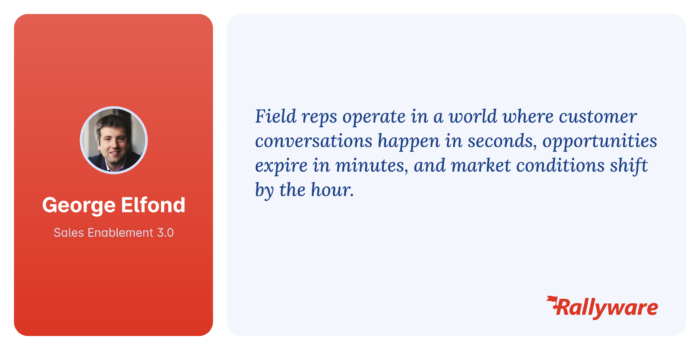Retail Customer Experience: An Interview with Juanjo Llopis, Director of Operations at Nike
Sales Enablement Strategy in 2025: Build a Plan Revenue Will Thank You For
What is a sales enablement strategy?
A sales enablement strategy isn’t just a plan—it’s the connective tissue between your sellers’ daily actions and your company’s revenue goals. It aligns training, content, coaching, and tools into a system that actually moves the needle.
Forget static decks and check-the-box training. A real strategy doesn’t stop at knowledge transfer—it drives behavior change. It ensures your reps know what to do, when to do it, and why it matters.
Modern enablement is about precision. It’s about surfacing the right action at the right time—guided by performance data, shaped by AI, and delivered through smart systems designed to build momentum, not just manage content.
Why does sales enablement strategy matter more than ever?
In 2025, sales teams are operating under more pressure—and with less margin for error—than ever before. Reps are scattered across roles, time zones, and tech stacks, trying to hit quota in an environment where every conversation counts and every minute matters.
At the same time, enablement leaders are being asked a hard question:
What’s all this really delivering?
Content completions and course attendance aren’t enough anymore. Revenue leaders want proof—real proof—that enablement moves the needle.
That’s why outdated strategies built around static training tracks or long-form content repositories are falling flat. They feel disconnected. Too slow. Too broad.
And they’re misaligned with how today’s buyers behave. According to Gartner, 75% of B2B buyers now prefer a rep-free experience—but 43% of those who self-serve report higher purchase regret. The takeaway? Your reps still matter—but only if they show up with the right message, at the right time, in the right way.
The teams seeing real results today are the ones who’ve flipped the model:
- They’re activating sales behaviors that drive performance, not tracking completions
- They’re embedding training and incentives into seller workflows, not stuck in portals
- They’re responding to performance data, not guessing at what’s needed
- And they’re aligned to business goals, not checklists
And behind many of these transformations? The right sales enablement software—tools designed not just to deliver content, but to drive the right actions at the right time, at scale.
Sales Enablement Strategy Guide :
Driving Revenue-Generating Behaviors at Scale
How Today’s Sales Enablement Leaders Are Evolving
Sales enablement isn’t just about onboarding or content delivery. The most successful organizations build systems that drive long-term, revenue-generating behaviors. This means turning enablement into a strategic function that instills habits, aligns learning with performance, and adapts to each rep’s needs in real time.
Traditional enablement approaches fall short because they focus on content completion over behavior change. To truly move the needle, you need a connected strategy—one that links data, learning, and incentives into a seamless experience that reinforces top-performing habits.
How Forward-Thinking Companies Are Leveraging Sales Enablement Differently
We’ve seen what works across hundreds of distributed sales teams—and across industries, consistent patterns emerge. These sales enablement best practices are helping top-performing teams drive real impact at scale. The sales enablement leaders who succeed do these four things exceptionally well:
1. They Align Learning with Doing
Learning content is most powerful when tied to real-world actions. Micro-learning that’s contextually delivered during daily workflows reinforces behavior and knowledge retention.
2. They Let Performance Data Drive the Experience
The most effective systems adapt in real time. Sales performance data should trigger relevant activities—whether it’s extra training, a motivational reminder, or a contest invite—so reps stay on track and never stall.
3. They Design Smarter Notifications and Reminders
Timing and context matter. Push notifications should feel like coaching, not noise. The right reminder at the right time builds trust and momentum.
4. They Incentivize What Matters
Gamification isn’t about badges—it’s about driving behaviors that correlate to outcomes. Our data shows that combining intrinsic and extrinsic motivators (recognition, competition, progress tracking) creates sustained engagement.
And behind many of these transformations? The right sales enablement software—tools designed not just to deliver content, but to drive the right actions at the right time, at scale.
Foundational Pillars of Scalable Enablement
Behavior-Based Onboarding
Don’t just teach product info—build muscle memory. A 30-60-90 day path should mirror the exact actions a top-performing rep would take in their first quarter.
Habit-Forming Training Journeys
Design learning tracks that are spaced, adaptive, and reinforced with tasks. The goal isn’t knowledge for knowledge’s sake—it’s repeatable behaviors that drive conversion.
Performance-Triggered Interventions
Enablement content, tasks, and rewards should be triggered based on real-time activity data—like low sales activity, missed KPIs, or positive momentum.
Integrated Tech Stack
Disconnected tools create friction. A single enablement layer should unify learning, communications, incentives, and analytics within your CRM and workflow tools.
Sales Incentives that Actually Work
Smart incentives are layered: recognition, leaderboard dynamics, monetary rewards, and progress-based bonuses. Incentives should align with desired micro-behaviors (e.g., pitching a new product, following up in <24h).

Next-Level Sales Enablement Strategy Checklist
Build your enablement strategy around the behaviors you want to scale—not just the content you want to share.
| Stage | Action | Why It Matters |
| 1. Set Your Strategic Goals | Define business objectives, not content outputs. | Are you trying to increase the average order value? Decrease ramp time? Define outcomes first. |
| 2. Audit Your Enablement Stack & Content | Assess tools, formats, and delivery. | Look at content and substance. Is it actionable? Mobile-first? Personalized? |
| 3. Map Behaviors to Outcomes | Create a behavior map linked to KPIs. | Identify what top performers do and build enablement around those actions. |
| 4. Design Smart Task Paths | Build adaptive learning journeys. | Use role, tenure, performance data to personalize. Avoid static training tracks. |
| 5. Integrate Performance Data | Feed sales KPIs into your enablement engine. | Trigger reminders, incentives, or retraining based on performance shifts. |
| 6. Automate Delivery | Use automation to assign the right content at the right time. | The system should reduce admin and free up managers to coach. |
| 7. Simplify Seller UX | One portal, one login, mobile-first. | Remove friction. Reps don’t need complexity—they need clarity. |
| 8. Layer in Effective Incentives | Go beyond gamification. | Blend leaderboards, challenges, progress bars, and monetary rewards. |
| 9. Continuously Optimize | Analyze, adapt, evolve. | Use analytics to refine content, journeys, and incentives monthly. |
| 10. Benchmark and Share Wins | Show success stories internally and externally. | Build momentum across teams and stakeholders. |
Real-World Sales Enablement Strategy Success Stories
Real enterprise companies are seeing the impact of implementing smarter sales enablement strategies. For example, Avon’s personalized, mobile-first onboarding program led to 124% higher orders from trained reps. Similarly, Merrell’s retailer training program boosted product sell-through by 44% through better content delivery.
These real-world examples validate the effectiveness of enablement strategies. They demonstrate how investing in enablement directly impacts sales performance.
The future of sales enablement strategy: How technology drives performance at scale

Sales strategy defines your go-to-market plan: who you target, how you position value, and how you win. Enablement brings that strategy to life—arming every rep to execute it with confidence, consistency, and impact. Together, they form the backbone of any scalable, revenue-generating sales motion.
But too often, companies stop at the planning phase. A slide deck. A playbook. A shiny new tool. And then… silence. Reps are expected to connect the dots on their own—at a time when pressure has never been higher.
According to Salesforce, 74% of sellers say their roles are becoming more consultative and less transactional. Yet most aren’t getting the training or support needed to succeed in that shift. Today’s reps aren’t just pitching—they’re guiding decisions, tailoring insights, interpreting data, and solving real customer problems. Without real enablement, even the best strategies fall flat.
That’s where technology becomes a force multiplier. As George Elfond wrote in Sales Enablement 3.0:
George Elfond, Sales Enablement 3.0
“Field reps operate in a world where customer conversations happen in seconds, opportunities expire in minutes, and market conditions shift by the hour.”
Content repositories and dashboards aren’t enough. Reps need behavior-based sales enablement strategies that adapt and activate action—intelligently, in real time.
Seismic’s 2024 State of Sales Enablement report backs this up: 89% of teams using enablement platforms say it gives them a competitive advantage. But that advantage only materializes when the tech is tied to strategy, performance data, and daily workflows. Otherwise, it’s just shelfware.
When strategy, enablement, and technology work hand-in-hand, reps don’t just know what to do—they know how, when, and why. And that’s when performance scales.
Sales enablement is evolving—fast
Great enablement isn’t about delivering more content—it’s about delivering the right behaviors, at scale. By aligning your strategy around actions, not assets, and powering it with smart automation and performance data, you can create a system that makes every seller feel coached, supported, and motivated.
AI-native platforms like Rallyware are defining the next generation of enablement. Instead of hoping reps will find the right content, these systems surface it at the exact moment it’s needed—based on live performance data and behavioral signals.
News and Insights on Workforce Training & Engagement
We’re among top-notch eLearning and business engagement platforms recognized for effective training and talent development, helping to empower distributed workforces
Subscribe
